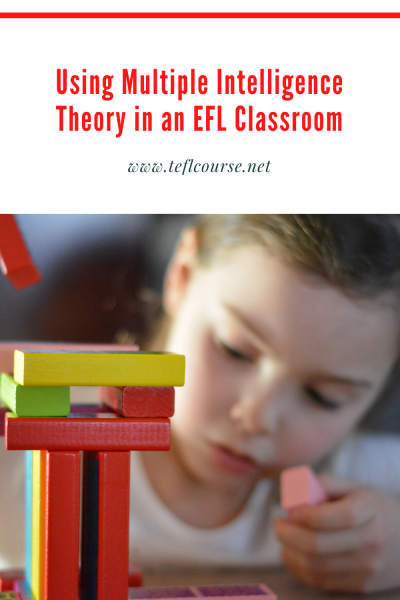Using Multiple Intelligence Theory in an EFL Classroom

In 1983, Dr. Howard Garner presented his theory of multiple intelligences in his book Frames of Mind: The Theory of Multiple Intelligences (1). His theory suggests that IQ, which is a more traditional form of measuring intelligence, is far too limited in its range of testing (1). Although not all of the intelligence included in the theory can be targeted easily when preparing a learning activity, multiple intelligence learning is a good theory to apply to teach English as a foreign language. This is because it can be used to teach at any level, and a strong intelligence can be used to develop skills involving a weaker one.
This post was written by our TEFL certification graduate Sidney M. Please note that this blog post might not necessarily represent the beliefs or opinions of ITTT.
Types of intelligences
Traditionally, most classes have been taught with teachers treating students as if they are all the same (2). Through his research, Dr. Gardner proposes that there are eight intelligences: Verbal-linguistic, logical-mathematical, visual-spatial, bodily-kinesthetic, musical-rhythmic, interpersonal, intrapersonal, and naturalist (3). A decade after his first book was published, he proposed a ninth intelligence of existentialist (2). Dr. Gardner’s theory stems from his belief that intelligence is not fixed at birth and is a dynamic phenomenon that occurs throughout a person’s mind, brain, and body (3). With multiple intelligence theory, all of the intelligences are thought to be of equal value (2). The intelligences are personal tools that can be used by each student to make sense of the information being taught in the most beneficial way for them to process it (2).
Also Read: Can I teach English abroad without any teaching experience?
Ways to use MI in class
In an EFL classroom setting, Multiple Intelligence Theory (MIT) can be used as an advantage when addressing student diversity. Depending on the type of class an EFL teacher is teaching, there can be a variance of levels of proficiency in English between the students. MIT can be applied to the learning environment, regardless of each students’ proficiency level. For example, when looking at the variable of age and working with young learners, teachers can implement the techniques of using physical activity, having the children draw or visualize an image, humming, or moving around objects to do with the subject (4). With the basis of MIT, it has been seen that these techniques make is easier for young students to formulate conversations and write about the topics presented in class (4). Other examples that involve the use of bodily-kinesthetic intelligence could be having the children act out a nursery rhyme or having them listen to a description in English and draw a picture of what they are hearing (4).

Another application of using MIT in an EFL classroom is using students’ stronger intelligences to develop skills that involve their weaker intelligences. These strengths and weaknesses are known as learning styles and can govern the ability with which a student can learn from a teacher using a specific teaching method (5). An example of using this to an advantage could be having a student with high proficiency in the area of musical-rhythmic intelligence use their strength to learn about history by writing a song about the historical event that the class is learning about (5). Implementing MIT in this way can help students use their strengths to enjoy learning about subjects that they used to hate because of difficulty due to it clashing with their learning style (5). In terms of learning in an ESL classroom, these methods can be used in the same way by having students perform activities that they enjoy, while simultaneously and successfully processing the English topics that they are being taught. Teachers can develop a curriculum based on a variety of activities that can help students to develop their different fields of intelligences in a way that makes their learning experience more entertaining and efficient (5). This type of curriculum is more student-centered and helps the students discover their learning styles (5).
Also Read: How much can I earn teaching English in Turkey?
Do you want to teach English abroad? Take a TEFL course!
Therefore, although it may not be easy to target all of the intelligences when preparing a learning activity for their class, teachers can make a great difference in how their students learn by employing MIT in the classroom, an EFL one or otherwise. This theory can effectively be used to teach students no matter their proficiency in the subject, and teachers can use the student’ strengths to develop skills involving intelligences in which students need more improvement. Having a more student-centered learning environment focuses on how they can succeed in their learning style. Breaking free from the rigid confines of traditional teaching and creating a more conducive environment for students will change the future of how English can be taught as a foreign language.
Apply now & get certified to teach english abroad!
Speak with an ITTT advisor today to put together your personal plan for teaching English abroad.
Send us an email or call us toll-free at 1-800-490-0531 to speak with an ITTT advisor today.
Related Articles:
- Cultural Sensitivity in the Classroom – Focus on Teaching English To Non-Native Speakers
- 6 Steps To Becoming a More Confident Teacher
- The 7 Biggest Myths About Teaching Abroad Alone as a Woman
- The Benefits of Volunteer English Teaching
- How I Accidentally Discovered My Passion For Teaching And Decided To Make It a Career
- 7 Fun Activities for Teaching Vocabulary in the ESL Classroom




